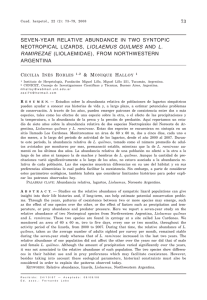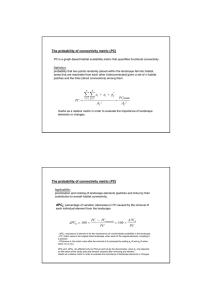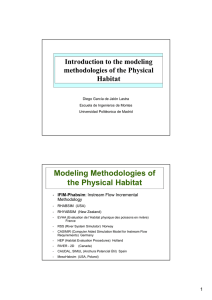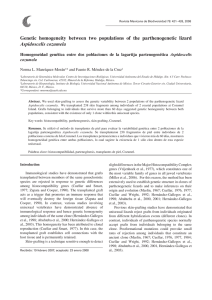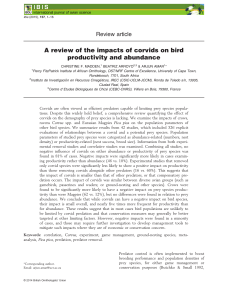Altitude and Rock Cover Explain the Distribution and Abundance of
Anuncio
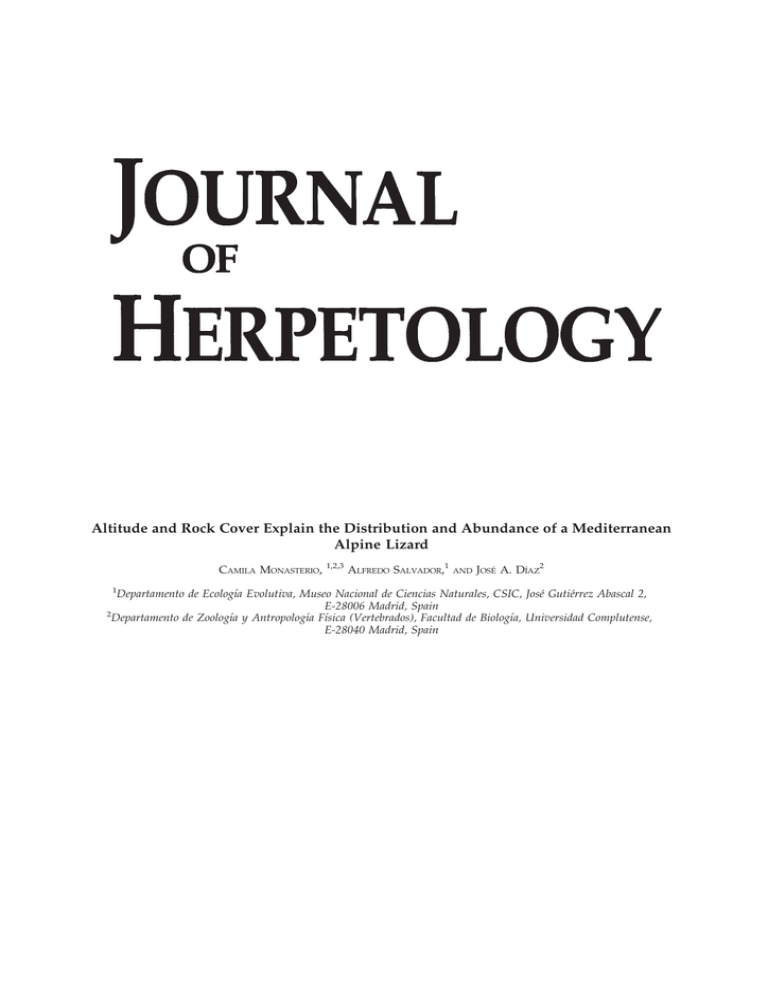
Altitude and Rock Cover Explain the Distribution and Abundance of a Mediterranean Alpine Lizard CAMILA MONASTERIO, 1 1,2,3 ALFREDO SALVADOR,1 AND JOSÉ A. DÍAZ2 Departamento de Ecologı́a Evolutiva, Museo Nacional de Ciencias Naturales, CSIC, José Gutiérrez Abascal 2, E-28006 Madrid, Spain 2 Departamento de Zoologı́a y Antropologı́a Fı́sica (Vertebrados), Facultad de Biologı́a, Universidad Complutense, E-28040 Madrid, Spain Journal of Herpetology, Vol. 44, No. 1, pp. 158–163, 2010 Copyright 2010 Society for the Study of Amphibians and Reptiles Altitude and Rock Cover Explain the Distribution and Abundance of a Mediterranean Alpine Lizard CAMILA MONASTERIO, 1,2,3 ALFREDO SALVADOR,1 AND JOSÉ A. DÍAZ2 1 2 Departamento de Ecologı́a Evolutiva, Museo Nacional de Ciencias Naturales, CSIC, José Gutiérrez Abascal 2, E-28006 Madrid, Spain Departamento de Zoologı́a y Antropologı́a Fı́sica (Vertebrados), Facultad de Biologı́a, Universidad Complutense, E-28040 Madrid, Spain ABSTRACT.—West European Rock Lizards within the Iberolacerta group have a restricted distribution, with small, widely separated ranges in highland areas. The aim of this study was to identify possible habitat requirements (including habitat structure, type of vegetation, and refuge availability) and topographic factors (altitude and orientation) that may determine variations in the abundance of Iberolacerta cyreni on a 300-km2 mountain range and to discuss the implications of our results for the conservation of this endangered endemism. Both a stepwise regression and a best model selection approach showed that lizard abundance was positively correlated with only two predictors: altitude and cover of large rocks. Thus, the successful exploitation of alpine habitats by I. cyreni seemed to depend on the abundance of large rocks that may provide suitable basking substrates while minimizing predation risk. The positive association between altitude and lizard abundance predicts a fragmented distribution with isolated populations in the mountain peaks. Mediterranean mountain ranges are unique ecological systems, where complex topography and historical climate changes have promoted high levels of diversity and endemicity (Taberlet et al., 1998; Hewitt 1999; Garcı́a-Barros et al., 2002). Moreover, their ecosystems are expected to be particularly sensitive to global change (Nogués-Bravo et al., 2007; Thuiller et al., 2005), which emphasizes the need to obtain reliable information on the altitudinal distribution of the organisms that are confined to these environments. For that purpose, a good starting point is to explore the correlations with both biotic and abiotic factors (Hoffmann and Blows, 1994; Holt, 2003; Fortin et al., 2005). This approach has been widely used in a variety of species including lizards (Dı́az and Carrascal, 1991; Dı́az, 1997; Fisher et al., 2002). The aim of this study was to identify possible habitat requirements (including habitat structure, type of vegetation, and refuge availability) and topographic factors (altitude and orientation) that may determine the range limits of an alpine Rock Lizard in a 300-km2 area in Central Spain. West European Rock Lizards within the Iberolacerta group have a restricted distribution, with small, widely separated ranges in highland areas, but the causes of their confinement remain largely unexplored. Iberolacerta cyreni is endemic to the Sistema Central mountains (Sierras de Guadarrama, Gredos, and Béjar), Spain. It was formerly considered a subspecies of Iberolacerta monticola but has recently achieved full species status based on morphological and molecular evidence (Arribas, 1996; Carranza et al., 2004; Crochet et al., 2004). This taxon is listed as Endangered in IUCN Red Lists because of its reduced extent of occurrence and acute fragmentation, with habitat loss and habitat degradation (e.g., development of infrastructure such as roads and ski resorts) being the major causes of its 3 Corresponding Author. E-mail: camila@mncn. csic.es declining population trend (Pérez-Mellado and Cheylan, 2005; Amo et al., 2007). Habitat preferences of this species have been previously analyzed by Martı́n and Salvador (1997), but only at a particular site at 1,900-m altitude. Therefore, it is of interest to explore the variations of lizard abundance at a larger, regional scale, covering the whole area of one of the three mountain ranges in which the species is known to be present. Moreover, the Sierra de Guadarrama, where our study was conducted, has been proposed to be declared a National Park, which emphasizes the concern about the degradation of this relevant natural site. Therefore, the results of this study may give helpful insights into management and conservation strategies that should help to preserve the vulnerable populations of this species and the welfare of its alpine habitat. MATERIALS AND METHODS Study Area.—The Sierra de Guadarrama is a mountain range located in Central Spain that extends over 80 km in a southwest to northeast direction, reaching its highest peak (Peñalara) at 2,428 m above sea level (a.s.l.). Its continental climate is characterized by contrasting seasonal conditions, with cold wet winters and marked summer droughts. Average minimum (February) and maximum (July) monthly temperatures are 23.3uC and 20.8uC (Puerto de Navacerrada meteorological station, 1,860 m a.s.l.), respectively. Average annual precipitation is 1,409 mm (Montero and González, 1984). Mountain bases (1,200–1,700 m a.s.l.) are covered with monospecific oakwoods of Quercus pyrenaica, which are progressively replaced by Scots Pine (Pinus sylvestris) forests at higher altitudes. These forested areas, that spread from 1,500–2,100 m a.s.l., gradually become sparse patches, until vegetation is dominated by a mosaic of dense mixed-shrub formations (of perennial Juniperus communis and Cytisus oromediterraneus) interspersed with small meadows (of Festuca and other grasses). SHORTER COMMUNICATIONS Mountain tops are also characterized by extensive patches of large granite rocks and scree with scattered shrub formations (Rivas-Martı́nez et al., 1987; Costa et al., 2005). Lizard Abundance and Habitat Characterization.—From May to July 2006, we carried out surveys to relate the abundance of I. cyreni with potentially important habitat variables in different sites of the Sierra de Guadarrama. Study sites (N 5 31) were spread throughout the mountain range, across an altitudinal gradient between 1,800 and 2,300 m a.s.l. The sampled surface covered an area of approximately 300 km2 including all the major alpine and subalpine habitat types. Thus, our range of habitats encompassed those in which this lizard is abundant (rock outcrops with mixed-shrub formations), together with those in which it is rare or practically absent (i.e., transition and pure pinewoods, respectively). Our sample of sites allowed different combinations of altitude, cardinal orientation, slope, and habitat structure. At each study site, one of us (CM) walked a 200-m transect counting the number of lizards seen within a 5-m wide belt (2.5 m each side of the progression line). This census belt width allowed us to detect all active lizards, either directly by sight or by hearing their escape movement in vegetated areas before identifying them. Censuses were done between 0900 and 1300 h (Mean European Time), only on sunny and windless days. All transects were repeated twice, and the maximum number of lizards observed was used as a relative abundance index. This simple index does not provide a measure of the actual density of lizards but allows between-habitat comparison of abundances, facilitating the detection of underlying biogeographical patterns (Dı́az and Carrascal, 1991; Fisher et al., 2002; Martı́n and López, 2002). Habitat structure, vegetation type, and distance to the nearest refuge (rock or shrub that could be a feasible shelter for lizards) were measured every 20 m along the transects (10 sampling points per transect). Four 5-m lines were laid out radiating from the sampling location into the four cardinal directions. At 1-m intervals along these lines, we registered the presence or absence of small rocks (,25-cm diameter), medium-sized rocks (25–100 cm), large rocks (.100 cm), grass, leaf litter, Cytisus oromediterraneus and Juniperus communis shrubs, and Pinus sylvestris saplings. This procedure resulted in 20 habitat measures per sampling point, which allowed calculation of the percent cover value for each habitat variable. These cover values were then averaged for each transect (Dı́az and Carrascal, 1991; Martı́n and Salvador, 1997; Dı́az et al., 2006). Variables related to the geographical position of the census sites were recorded using a GPS GARMIN H (UTM coordinates, altitude) or obtained from 1 : 25,000 maps from the Servicio Cartográfico Regional de España (slope and cardinal orientation). To adequately quantify the orientation of transects giving higher values to more southerly orientations (Huertas and Dı́az, 2001), we used the negative cosine of the cardinal orientation of the transect slopes. Data Analyses.—Because of the exploratory and correlational nature of our data set, we were particularly careful in applying several statistical techniques to identify the most relevant predictors of lizard 159 TABLE 1. Habitat variables (N 5 31) measured along the transects or obtained with a GPS (altitude) or from 1 : 25,000 maps (orientation). Cover values are given in percentages. Mean 6 SD Leaf litter cover Grass cover Small rock cover (,25 cm diameter) Medium sized rock cover (25–100 cm diameter) Large rock cover (.100 cm diameter) Cytisus oromediterraneus shrub cover Juniperus communis shrub cover Pinus sylvestris saplings cover Distance to nearest refuge (cm) Altitude (m a.s.l.) Orientation (negative cosine of cardinal orientation) 14.4 6 13.3 24.7 6 9.1 6.4 6 6.9 10.6 8.1 22.6 21.1 3.4 52 1978 6 6 6 6 6 6 6 8.2 7.9 15.1 15.2 4.3 44 118 0.157 6 0.682 abundance. For that purpose, we combined the traditional null hypothesis testing approach with inferences based on model selection (Johnson and Omland, 2004). We performed a preliminary Principal Component Analysis (PCA) to explore the structure of the correlation matrix among the microhabitat variables involved (Table 1), and we noted which variables had the greatest loadings on each principal component. These variables, together with the topographic ones (i.e., altitude and orientation) and the mean distance to the nearest refuge (which was excluded by design from the PCA to keep refuge availability as a separate variable), were introduced as predictors in a Stepwise Multiple Regression analysis. Normality of regression residuals was examined using normal probability plots. To corroborate the adequacy of our predictive model, we used the Akaike Information Criterion (AIC), which is the most widely used computational approach to model selection. Prior to these analyses, variables were checked for normality using Shapiro-Wilk’s tests, and logarithmic transformations were applied when necessary. Because spatial autocorrelation could affect our results (because two closely located sampling sites are likely to be more similar to each other than two distantly located sites), we simultaneously tested for spatial effects (Legendre’s polynomial; Borcard et al., 1992), topography, and habitat factors as determinants of lizard abundance. RESULTS The exploratory PCA with habitat variables yielded four factors that accounted for 76% of the variance (Table 2). The following variables presented the highest loadings for each factor: leaf litter cover (PC1, a component giving high scores to cleared pine-forests with a high cover of pines and leaf litter), large rocks (PC2, a component contrasting meadows without rocks to sites with a high cover of large rocks), J. communis shrub cover (PC3), and C. oromediterraneus shrub cover (PC4, a component contrasting rock scree areas to sites with a high Cytisus shrub cover). These four variables were used, together with the topographic ones (altitude and orientation) and the mean 160 SHORTER COMMUNICATIONS TABLE 2. Principal components analysis with the microhabitat variables shown in Table 1. Factor loadings greater than 0.6 (P 5 0.00036) are shown in bold type. Leaf litter cover Grass cover Small rock cover (,25 cm diameter) Medium sized rock cover (25–100 cm diameter) Large rock cover (.100 cm diameter) Cytisus oromediterraneus shrub cover Juniperus communis shrub cover Pinus sylvestris saplings cover Eigenvalue Proportion of explained variance distance to the nearest refuge, in the subsequent analyses, after having checked that all tolerance values were higher than 0.5 to avoid inconsistent results generated by stepwise procedures when explanatory variables are highly collinear. Lizards were detected in 21 of 31 transects, and their numbers ranged from zero to nine individuals per transect. A stepwise multiple regression (R2 5 0.67, F2,28 5 28.5, P , 0.0001) showed that lizard abundance was positively correlated with altitude (b 5 0.57, P , 0.0001) and cover of large rocks (b 5 0.52, P , 0.0001); these two variables were largely independent, with a tolerance value .0.98. Thus, Rock Lizards reached high population densities at high-altitude sites where large rocks were abundant (Fig. 1). We found no sign of spatial autocorrelation, because a multiple regression with spatial (Legendre’s polynomial), topographic, and habitat variables did not alter our results: altitude and large rock cover were the only variables with significant partial correlations. These variables also provided the best predictive model following the AIC model selection approach, either with or without a correction term for small sample size. Altitude was the first variable to enter all the best models obtained, and cover of large rocks was the second variable in five of the six best models, including the three first ones (Table 3). DISCUSSION Our main result is that the abundance of I. cyreni was positively correlated with only two predictors: altitude and cover of large rocks. Although the ecological mechanisms involved in this distribution pattern remain to be clarified, our data suggest that the ability of lizards to thrive in high-altitude environments was greater at those sites where large rocks were more abundant. This can be partially explained by their morphological adaptations, with a dorsoventrally compressed skull, which illustrates their specialization as scansorial, rock-dwelling lizards that usually seek shelter in narrow crevices (Arnold, 1973). However, there are other behavioral and ecological considerations that should also be addressed. West European Rock Lizards within the Iberolacerta group have a restricted distribution, with small, widely separated ranges in highland areas (Carranza et al., 2004), and these and other highaltitude lacertids seem to be adapted to the challenging thermal conditions of alpine environments (Van PC1 PC2 PC3 PC4 0.885 0.162 20.498 20.546 20.167 20.241 20.196 0.753 2.046 0.256 20.147 20.679 20.470 0.123 0.846 0.039 0.087 0.321 1.547 0.193 20.121 0.404 20.517 20.198 0.076 20.254 0.837 20.277 1.333 0.167 20.112 20.240 20.024 20.627 20.183 0.804 0.190 20.021 1.180 0.147 Damme, 1989; Bauwens et al., 1990). Prior research at a smaller microhabitat scale showed that I. cyreni selected large rocks and avoided grass cover (Martı́n and Salvador, 1997), which can be attributed to the suitability of open rocky habitats as basking and refuge sites. Attaining optimal body temperatures without overexposure to predators must be particularly difficult in high-altitude environments, where these heliothermic lizards thermoregulate by means of long basking periods (Carrascal et al., 1992) and adjust FIG. 1. Scatterplots of (A) the residuals of the regression of lizard abundance on altitude versus rock cover; and (B) the residuals of the regression of lizard abundance on rock cover versus altitude. SHORTER COMMUNICATIONS 161 TABLE 3. Best model selection approach to predict the abundance of rock lizards as a function of the microhabitat and topographic variables shown in Table 1. The best six models, with Akaike Information Criteria (AIC) smaller than minimum AIC + 2, are shown. AICc 5 Akaike Information Criterion corrected for small sample size. Model 1st variable 1 2 3 4 5 6 Altitude Altitude Altitude Altitude Altitude Altitude 2nd variable Cover of large Cover of large Cover of large Orientation Cover of large Cover of large rocks rocks rocks rocks rocks 3rd variable Distance to refuge Cover of Cytisus Cover of large rocks Cover of Juniperus Cover of Juniperus their proximity to refuges as a function of their ability to escape from a predator (Martı́n and López, 2001). Altitude was the single independent variable that most accurately predicted variations in lizard abundance. Moreover, assuming a mean cover of large rocks of 8.1% (equivalent to the average value for the 31 transects examined; see Table 1), our regression model predicts that lizard populations should disappear below 1,650 m a.s.l., a value which is fairly close to the lower altitudinal limit of this alpine species. The question of what factors represent an ecological barrier to I. cyreni remains to be clarified. For instance, it would be useful to study the thermoregulatory effectiveness of populations living at different altitudes with contrasted environmental conditions (e.g., refuge availability or operative temperatures available). It has also been proposed that past competition with species of the Podarcis group may be responsible for the restriction of I. cyreni and other species of Iberolacerta (Carranza et al., 2004), but this hypothesis seems unlikely because other lacertid species (e.g., Podarcis muralis) were very scarce in the areas sampled, independent of the abundance of I. cyreni. Our results could be useful to adequately manage the populations of this endangered species. The Sierra de Guadarrama has been suffering from varied anthropogenic disturbances that entail habitat deterioration, such as forest exploitation, the construction of ski resorts, and growing urbanization. The positive relationship between lizard abundance and large rock cover revealed in our study highlights the need to manage this mountain range adequately, without reducing the availability of the lizards’ preferred habitat. The harmful effects of habitat degradation by rock disturbance have already been reported for other reptilian species (Schlesinger and Shine, 1994; Goldingay and Newell, 2000; Goode et al., 2005; Dı́az et al., 2006), suggesting that avoiding the deterioration of rock outcrops is a basic priority to prevent their decline. Furthermore, it has been shown that the body condition of Rock Lizards inhabiting ski slopes is negatively affected by behavioral adjustments induced by increased predation risk (Amo et al., 2007). In the Sierra de Guadarrama, there are two main ski slopes coinciding with the preferred habitat of Rock Lizards, but they cover less than 5% of the area suitable for the species in this mountain range. However, our results should be taken into account either for expanding the skiable area (which would be detrimental for I. cyreni) or for restoring the current ski 4th variable Distance to refuge AIC AICc 121.38 121.85 123.13 123.36 123.36 123.38 122.27 125.39 126.67 126.90 126.90 126.92 resorts and adjacent areas. In fact, the restoration of habitat simulating natural retreat sites is a successful technique to manage reptile species inhabiting rocky outcrops (Cheylan et al., 1990; Webb and Shine, 2000). In conclusion, I. cyreni shows a restricted distribution pattern along the Sierra de Guadarrama that seems to be mediated by large rock abundance in high-altitude habitats. The species is locally very abundant in alpine remnant patches of rock outcrops and mixed shrub in the mountain range peaks, but it is absent from the surrounding forested belt and from the urbanized areas located at lower altitudes. Our model, which should be corroborated by future studies in other mountain ranges inhabited by I. cyreni (Sierras de Gredos and Béjar), indicates that high-altitude rocky areas are crucial for the survival of this species. It should also be noted that the positive association between altitude and lizard abundance is expected to produce a fragmented distribution that could be affected by metapopulation dynamics. Thus, it would be of great interest to discern whether this apparently fragmented spatial pattern actually represents isolated populations in the mountain peaks. For that purpose, we encourage the use of molecular techniques (i.e., microsatellites, mitochondrial DNA) to assess genetic flow between populations and to discriminate between historical and recent fragmentation events (Berry and Gleeson, 2005; Huey et al., 2006). Acknowledgments.—We thank G. Perry and two anonymous reviewers for their constructive comments on the manuscript. This paper is a contribution to the project CGL2007-02744/BOS, funded by the Spanish Ministry of Education and Science. CM was funded by a CSIC-El Ventorrillo grant. We have complied with all applicable institutional Animal Care guidelines, and all required permissions were provided from the Direccion General del Medio Natural of the Madrid and Castilla y León region. LITERATURE CITED AMO, L., P. LÓPEZ, AND J. MARTÍN. 2007. Habitat deterioration affects body condition of lizards: a behavioral approach with Iberolacerta cyreni lizards inhabiting ski resorts. Biological Conservation 135:77–85. ARNOLD, E. N. 1973. Relationships of the Palaearctic lizards assigned to the genera Lacerta, Algyroides and Psammodromus (Reptilia: Lacertidae). Bulletin 162 SHORTER COMMUNICATIONS of the British Museum of Natural History 25: 291–366. ARRIBAS, O. 1996. Taxonomic revision of the Iberian ‘‘Archaeolacertae’’ I: a new interpretation of the geographical variation of ‘‘Lacerta’’ monticola Boulenger, 1905 and ‘‘Lacerta’’ cyreni Müller and Hellmich, 1937 (Squamata: Sauria: Lacertidae). Herpetozoa 9:31–56. BAUWENS, D., A. M. CASTILLA, R. VAN DAMME, AND R. F. VERHEYEN. 1990. Field body temperatures and thermoregulatory behavior of the high altitude lizard Lacerta bedriagae. Journal of Herpetology 24:88–91. BERRY, O., AND D. M. GLEESON. 2005. Distinguishing historical fragmentation from a recent population decline—shrinking or pre-shrunk skink from New Zealand? Biological Conservation 123:197– 210. BORCARD, D., P. LEGENDRE, AND P. DRAPEAU. 1992. Partialling out the spatial component of ecological variation. Ecology 73:1045–1055. CARRANZA, S., E. N. ARNOLD, AND F. AMAT. 2004. DNA phylogeny of Lacerta (Iberolacerta) and other lacertine lizards (Reptilia: Lacertidae): did competition cause long-term mountain restriction? Systematics and Biodiversity 2:57–77. CARRASCAL, L. M., P. LÓPEZ, J. MARTÍN, AND A. SALVADOR. 1992. Basking and antipredator behaviour in a high altitude lizard: implications of heat-exchange rate. Ethology 92:143–154. CHEYLAN, G., A. MEGERLE, AND J. RESCH. 1990. La Crau, Steppe Vivante. Guide du naturaliste dans le désert provençal. Radolfzell. Ed. Jürgen Resch, Germany. COSTA, M., C. MORLA, AND H. SANZ. 2005. Los Bosques Ibéricos : Una Interpretación Geobotánica. Editorial Planeta, S.A., Barcelona, Spain. CROCHET, P. A., O. CHALINE, Y. SURGET-GROBA, C. DEBAIN, AND M. CHEYLAN. 2004. Speciation in mountains: phylogeography and phylogeny of the rock lizards genus Iberolacerta (Reptilia : Lacertidae). Molecular Phylogenetics and Evolution 30:860–866. DÍAZ, J. A. 1997. Ecological correlates of the thermal quality of an ectotherm’s habitat: a comparison between two temperate lizard populations. Functional Ecology 11:79–89. DÍAZ, J. A., AND L. M. CARRASCAL. 1991. Regional distribution of a Mediterranean lizard: influence of habitat cues and prey abundance. Journal of Biogeography 18:291–297. DÍAZ, J. A., C. MONASTERIO, AND A. SALVADOR. 2006. Abundance, microhabitat selection, and conservation of eyed lizards Lacerta lepida: a radiotelemetric study. Journal of Zoology 268:295–301. FISHER, R. N., A. V. SUAREZ, AND T. J. CASE. 2002. Spatial patterns in the abundance of the coastal horned lizard. Conservation Biology 16:205–215. FORTIN, M. J., T. H. KEITT, B. A. MAURER, M. L. TAPER, D. M. K AUFMAN , AND T. M. B LACKBURN . 2005. Species’ geographic ranges and distributional limits: pattern analysis and statistical issues. Oikos 108:7–17. GARCÍA-BARROS, E., P. GURREA, M. J. LUCIÁÑEZ, J. M. CANO, M. L. MUNGUIRA, J. C. MORENO, H. SAINZ, M. J. SANZ, AND J. C. SIMÓN. 2002. Parsimony analysis of endemicity and its application to animal and plant geographical distributions in the Ibero-Balearic region (western Mediterranean). Journal of Biogeography 29:109–124. GOLDINGAY, R. L., AND D. A. NEWELL. 2000. Experimental rock outcrops reveal continuing habitat disturbance for an endangered Australian snake. Conservation Biology 14:1908–1912. GOODE, M. J., W. C. HORRACE, M. J. SREDL, AND J. M. HOWLAND. 2005. Habitat destruction by collectors associated with decreased abundance of rockdwelling lizards. Biological Conservation 125: 47–54. HEWITT, G. M. 1999. Post-glacial re-colonization of European biota. Biological Journal of the Linnean Society 68:87–112. HOFFMANN, A. A., AND M. W. BLOWS. 1994. Species borders—ecological and evolutionary perspectives. Trends in Ecology and Evolution 9:223– 227. HOLT, R. D. 2003. On the evolutionary ecology of species’ ranges. Evolutionary Ecology Research 5:159–178. HUERTAS, D. L., AND J. A. DÍAZ. 2001. Winter habitat selection by a montane forest bird assemblage: the effects of solar radiation. Canadian Journal of Zoology 79:279–284. HUEY, J. A., J. M. HUGHES, AND A. M. BAKER. 2006. Patterns of gene flow in two species of eel-tailed catfish, Neosilurus hyrtlii and Porochilus argenteus (Siluriformes: Plotosidae), in western Queensland’s dryland rivers. Biological Journal of the Linnean Society 87(3): 457–467. JOHNSON, J. B., AND K. S. OMLAND. 2004. Model selection in ecology and evolution. Trends in Ecology and Evolution 19:101–108. MARTÍN, J., AND P. LÓPEZ. 2001. Repeated predatory attacks and multiple decisions to come out from a refuge in an alpine lizard. Behavioral Ecology 12:386–389. ———. 2002. The effect of Mediterranean dehesa management on lizard distribution and conservation. Biological Conservation 108:213– 219. MARTÍN, J., AND A. SALVADOR. 1997. Microhabitat selection by the Iberian Rock Lizard Lacerta monticola: effects on density and spatial distribution of individuals. Biological Conservation 79:303–307. MONTERO, J. L., AND J. L. GONZÁLEZ. 1984. Diagramas Bioclimáticos. ICONA, Madrid, Spain. NOGUÉS-BRAVO, D., M. B. ARAÚJO, J. P. MARTINEZ-RICA, AND M. P. E RREA . 2007. Exposure of global mountain systems to climate change. Global Environmental Change 17:420–428. PÉREZ-MELLADO, V., AND M. CHEYLAN. 2005. Iberolacerta cyreni. In 2006 IUCN Red List of Threatened Species. [cited 2006 Nov 14] Available from: www.redlist.org. RIVAS-MARTÍNEZ, S., F. FERNÁNDEZ-GONZÁLEZ, AND D. SÁNCHEZ MATA. 1987. E1 Sistema Central: de la Sierra de Ayllón a la Sierra da Estrela. In M. Peinado-Lorca and S. Rivas-Martinez (eds.), La Vegetación de España, pp. 419–451. Universidad de Alcalá de Henares, Madrid, Spain. SHORTER COMMUNICATIONS SCHLESINGER, C. A., AND R. SHINE. 1994. Choosing a rock: perspectives of a bush-rock collector and a saxicolous lizard. Biological Conservation 67: 49–56. TABERLET, P., L. FUMAGALLI, A. G. WUST-SAUCY, AND J.-F. COSSON. 1998. Comparative phylogeography and postglacial colonization routes in Europe. Molecular Ecology 7:453–464. THUILLER, W., S. LAVOREL, M. B. ARAÚJO, M. SYKES, AND I. C. PRENTICE. 2005. Climate change threats to plant diversity in Europe. Proceedings of the National Academy of Science USA 102:8245–8250. 163 VAN DAMME, R., D. BAUWENS, A. M. CASTILLA, AND R. F. VERHEYEN. 1989. Altitudinal variation of the thermal biology and running performance in the lizard Podarcis tiliguerta. Oecologia 80:516–524. WEBB, J. K., AND R. SHINE. 2000. Paving the way for habitat restoration: can artificial rocks restore degraded habitats of endangered reptiles? Biological Conservation 92:93–99. Accepted: 18 March 2009.
